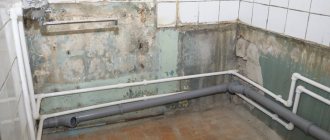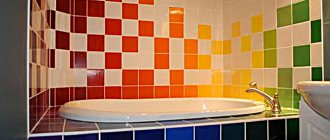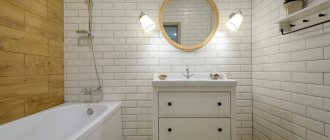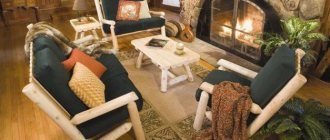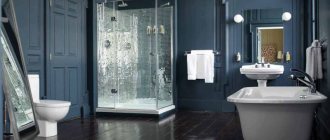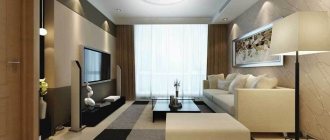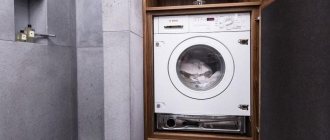Plastic panels
Let’s make a reservation right away: you can use these panels, but they are not comparable to tiles. However, today there are many different types of plastic panels that are made using different technologies and different sizes.
If the surface of the bathroom is not ideal, then plastic panels are mounted on the frame. If your walls are smooth and plastered, then plastic panels can be attached to liquid nails.
The sheets are joined closely to each other, which creates the illusion of a seamless surface.
It is worth choosing materials that do not emit toxic elements when the walls are heated.
Plastic panels
If you do not want to use tiles as finishing, then pay attention to plastic panels. They are perfect for decorating walls in the bathroom and are a good replacement for wallpaper in the toilet. Thanks to this facing material, you can almost instantly make the surface perfectly smooth.
Plastic panels on the walls instead of wallpaper and tiles
Important! This material can be installed even on old coverings, for example, wallpaper or tiles. Of course, if the size of the room allows this, since in this case you will steal some of the living space of the bathroom or toilet.
Decorating the floor with something to replace tiles
Facing with cork material
Such panels are not afraid of excessive levels of moisture and water. But, like any material, panels also have disadvantages. It is worth noting that they cannot withstand strong shock loads. This type of floor is easy to damage. That is why panels should not be used as floor finishing. And for walls this option is quite suitable.
Decorating with panels other than tiles
Dye
If you decide to use paint for your bathroom, you should know the following:
- the walls must be perfectly smooth;
- When preparing walls, it is necessary to follow the entire technological process (from primer to putty).
Paint itself is a very suitable material for a bathroom. Thanks to its properties, it perfectly protects walls from the appearance of fungus and mold. Plus, repainting walls is much easier than re-tileing.
Paint can be applied in various ways. From a perfectly smooth surface to a decorative one, you can create it using modern paint.
Waterproof laminate
It is used quite rarely, so really high-quality products of this kind are expensive and difficult to find on sale. However, if the interior requires it, such a laminate is quite suitable for use in the bathroom. Its layers are impregnated with waxes, which give them hydrophobic properties. Thus, even if water gets between the slots of the locks, the panels do not swell and do not lose their appearance.
Special requirements are imposed on the laying and sealing of seams. If the panels themselves are not in danger, then mold may form in the cracks over time if moisture gets there. The disadvantages also include the difficulty of installation with non-standard bathroom geometry - you will have to do curly cutting.
What are the sizes of floor tiles?
Floor tiles have become a popular way to decorate an apartment today. If previously it was placed only in the toilet and bathroom, today it can often be found in the hallway, kitchen, and sometimes in the living room. High-quality material is not cheap, so you don’t want unused panels to remain during installation or, conversely, not enough of them to cover the entire area.
Self-adhesive films
Something very similar to moisture-resistant wallpaper, only the material on the back has a sticky layer that is ready for use. You simply take and stick the film to the walls.
It is worth noting that your walls must be without a single defect, otherwise it will all show through the film.
When covering the walls with film, try not to leave air bubbles inside. If bubbles do appear, then take a thin needle and make a puncture, then smooth the film.
Ceramic tile
The most familiar material that has become a classic. Fits into any interior style, has a huge number of designs. Now there are three main types on the market - ceramic, metlakh and porcelain stoneware. They differ slightly from each other in strength characteristics, wear resistance and manufacturing methods.
They have a number of common advantages over other coatings:
- wear-resistant;
- resistant to water, temperature and humidity changes;
- can be treated with antifungal components;
- smooth and embossed models;
- variety of colors and patterns.
There are also negative qualities. For example, the surface is often cold to the touch, so it is recommended to install a “warm floor” system along with the tiles.
It is very easy to slip on tiles, so you should pay attention to models with uneven terrain.
How to cover the bathroom floor other than tiles
From the walls we move to the floor. What can you use to cover the bathroom floor other than tiles?
There are two alternative coating options on the market:
- PVC panels;
- moisture resistant laminate.
PVC panels are inexpensive, but for installation you need to have an ideal floor, without any differences.
Moisture-resistant laminate is more expensive, but its quality will not be inferior to some types of tiles.
Thus, we considered the topic of choosing alternative options for finishing the bathroom. What to choose? Decide for yourself!
Types of decorative finishes
- Linoleum or vinyl tiles. This is a budget option, it is perfect if you need to make inexpensive but high-quality repairs.
- Laminate. A somewhat unexpected decision, since most consumers are well aware that laminate does not tolerate moisture well. In fact, everything is simpler - you should use moisture-resistant types of material for the bath.
- Polyurethane. You can create a seamless and original-looking floor covering using self-leveling technology.
- Cork. This is a very comfortable but quite expensive finishing option.
Let us consider the features of each of the listed materials in more detail.
The main criterion that most strongly influences the choice of flooring is the moisture resistance of the finishing material. In the bathroom, even with powerful ventilation, air humidity is often increased, and the floor undergoes direct contact with water every day.
Bathroom flooring must be waterproof
If the coating is afraid of moisture, microscopic cracks will begin to appear on it. Water will sooner or later reach the substrate, causing it to rot and become moldy. Moreover, insufficiently moisture-resistant materials can cause flooding of neighbors and peeling of the coating. Ideally, the floor will also have waterproofing properties, that is, protect the inner layers of the flooring from water.
Other requirements for floor coverings:
- Safety and environmental friendliness. The material will be used indoors and subject to temperature changes. If there are toxic substances in the composition, there is a risk of their release in gaseous form. The coating must remain 100% safe even when heated and wet, and must not support the growth of microorganisms.
- Strength. The intensity of use of the floor in the bathroom is high, and care in handling it is not always observed. Therefore, the material must withstand shock loads, scratches, and other types of mechanical loads without problems. In addition, it should not be pushed through by installed plumbing fixtures.
- Easy to install. If you will be renovating the bathroom yourself, it is better to choose affordable materials. They are easy to install and do not require complex trimming or the purchase of expensive tools. It is ideal if the floor covering does not involve dirty work that leads to a large amount of dust.
- Easy to care for and chemical resistance. The less dirty the surfaces in the bathroom are, the less often they will need to be washed. This requirement is met by materials with a finely porous structure, on which dirt does not linger. During washing, the coating should easily withstand contact with standard detergents and not deteriorate from other types of aggressive influences.
- Long service life. Bathroom renovations are not carried out too often, because they are expensive and labor-intensive. Therefore, the floor covering must be wear-resistant and last a long time, at least 10 years without the need for restoration.
We invite you to familiarize yourself with Marble chips in the bathroom
Ease of cleaning is important for bathroom floors
There are several types of materials suitable as bathroom flooring. They have different properties and have their own advantages and disadvantages.
PVC tiles
Tiles or panels made of cellular polyvinyl chloride look like cut linoleum and come in a variety of colors. Most often, PVC coatings with element sizes of 30*30 or 40*40 cm are found on sale, but there are also larger lamellas (width - 80-200 cm, length - 150-300 cm).
Self Adhesive Waterproof PVC Tiles
PVC is easy to install because it has an adhesive backing. To secure it, simply remove the film and lean the element against the prepared surface. If an individual tile is damaged, it can be easily replaced by tearing it off and gluing a new one. At a low cost, PVC tiles imitate more expensive materials - stone, parquet. It is smooth, pleasant to the touch, and can withstand heavy loads.
This material also has disadvantages:
- there are many seams into which water penetrates;
- risk of peeling off if very wet;
- unaesthetic appearance during long-term use;
- frequent swelling at the edges;
- susceptibility to fading from ultraviolet radiation.
Using vinyl tiles in the bathroom
To avoid problems with warping and rotting of wooden structures, the floor in the bathroom is made in the image and likeness of the structure used in the steam room of a bathhouse or the deck of a fishing schooner. In fact, the wooden floor is double:
- The lower subfloor is also called wet; it collects all the water, dirt and residual detergents that fall on the bathroom floor;
- The upper wooden floor should be made from waterproof types of wood, preferably ash or oak.
Larch is considered to be the most resistant, but in practice there are not many people who want to install and walk on a dark and not very attractive surface in the bathroom, so bleached and tinted oak is best suited.
The lower subfloor must be thoroughly waterproofed. To do this, you can use liquid rubber as the first layer, or a special coating butyl-styrene waterproofing used to insulate the bowls of swimming pools, ponds and large concrete tanks.
If the subfloor is made of boards, then before installing waterproofing, it is necessary to sew the floorboards at the joints with nails or screws, remove the paint and sand the surface with coarse sandpaper.
The base of the subfloor is impregnated with an antiseptic and thoroughly dried. If the base is concrete, then you will need to insulate the bathroom floor with polystyrene foam, lay down moisture-resistant plywood, install support joists for the finished wooden floor in the bathroom, and only after that apply coating waterproofing.
After the insulation layer has dried, all that remains is to lay the top finishing floor. Pre-planed boards treated with waterproof varnish are laid on joists on tenons or wooden pins. You cannot hit nails or screw screws into wood. Even if you put a layer of protective varnish on top, the attachment points will rust.
The result is a very beautiful and durable bathroom floor.
The age-old problem of how and what to put on the bathroom floor can be solved in a fairly simple way. To create the most beautiful, warm and environmentally friendly coating, you only need to use special types of wood-based materials or waterproof wood species:
- Larch;
- Oak;
- Ash;
- Thermostatic wood.
All of the listed types of wood cope well with water. You only need to waterproof the base using coating mastic and lay a thick plastic film. The wooden floor can be laid on slats or glued directly to the base.
To prevent moisture from seeping through the joints, molten mastic based on pine resin is poured into the seams. Next, you will need to put a fiber cord into the joints and fill the seams with polyurethane varnish or epoxy glue. The service life of a wooden floor in a bathroom is at least 10 years.
Self-leveling floors
Some of the best bathroom floors when it comes to performance and aesthetics alone. In fact, this is an artistic version of floor screed, which is made of durable polymer or concrete with decorative admixtures.
The cleaned floor surface is simply filled with the compound, carefully leveled, and in some cases additional polishing is required. The concrete mass accommodates a floor heating system well.
The positive characteristics include the following:
- no seams - water will not penetrate anywhere;
- ease of care;
- if you make a small margin along the walls, then you can almost completely eliminate leaks to your neighbors;
- many options for decorative finishing (for example, filling in sectors, etc.).
The whole truth about quartz-vinyl floor tiles
To decide whether this coating can take root in your interior, consider its strengths and look for weaknesses.
The main negative points are the high price and the need for careful installation.
